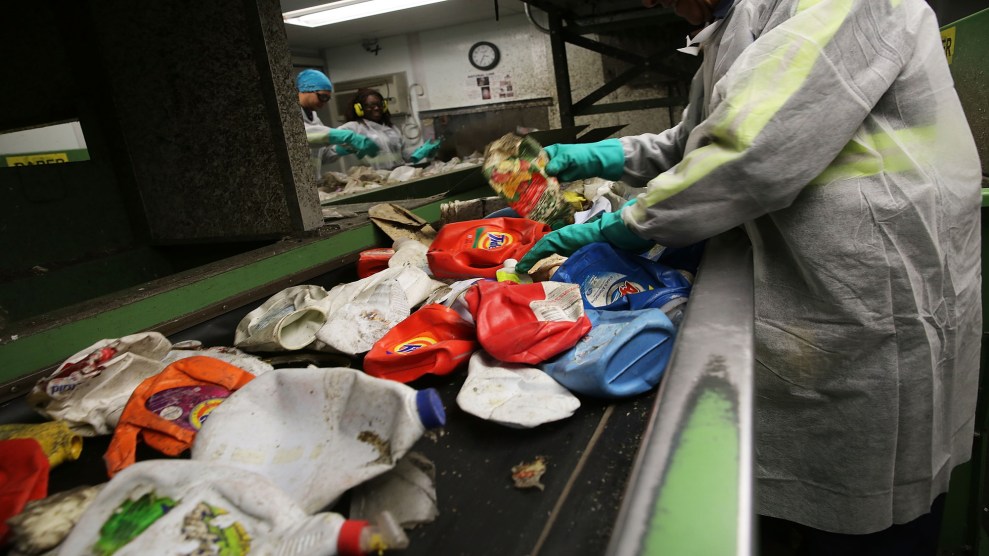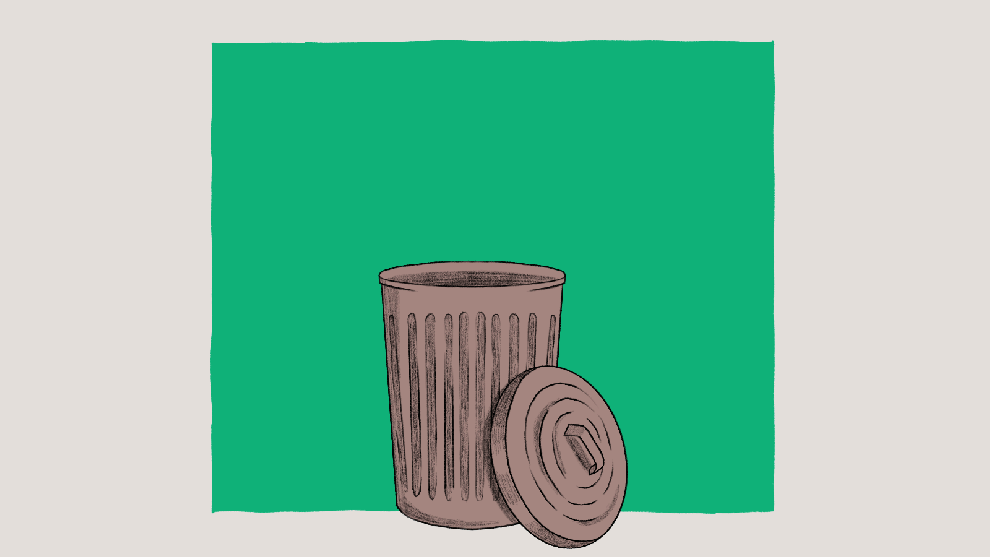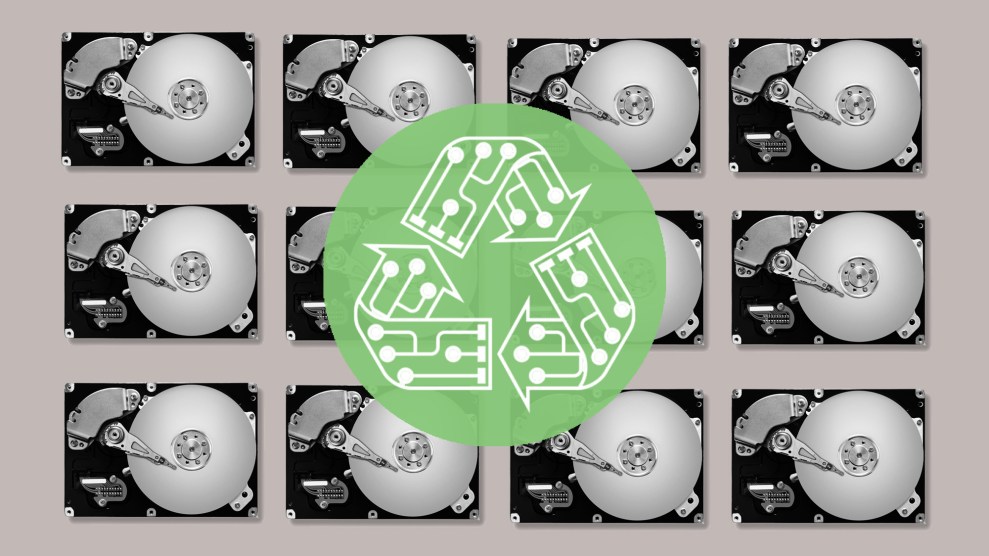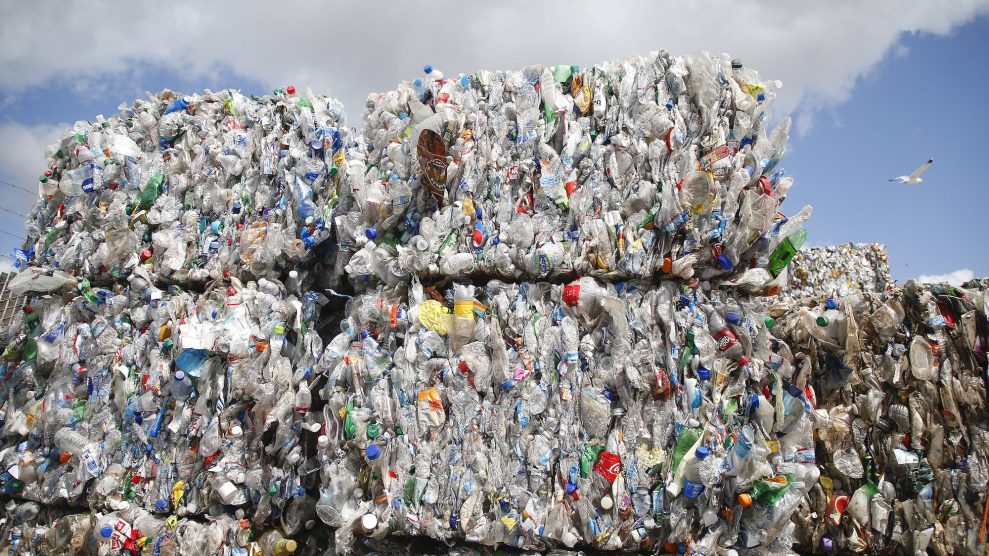
Recycling is sorted at the Sims Municipal Recycling Facility, an 11-acre recycling center on the Brooklyn waterfront in New York City. Spencer Platt/Getty
This story was originally published by Undark and is reproduced here as part of the Climate Desk collaboration.
To jumpstart a paltry market for recycled plastic, governments across the globe are pushing companies to include recycled materials in their products. Last year, the United Kingdom introduced a tax on manufacturers that produce or import plastic packaging containing less than 30 percent recycled plastic. In 2024, New Jersey will begin enforcing similar rules, albeit with lower targets. California now requires that beverage containers be made of 15 percent recycled materials, and Washington will enact a similar requirement later this year. The European Commission, Canada, and Mexico are all considering comparable moves.
Currently, most plastic products are derived from freshly extracted fossil fuels, including crude oil and natural gas. Incorporating some recycled plastic could reduce emissions, and shrink pollution in waterways and landfills, experts say. But collecting, sorting, pulverizing, and melting post-consumer plastics for reuse is expensive. The new laws will potentially help recyclers find buyers for what would otherwise become waste.
But regulators may need a better way to verify that the new laws are working. While companies can enlist a third-party to certify their use of recycled content, most certifiers take a bird’s-eye view, tracking the materials across a range of products and factories. As a result, an item with a “recycled content” label might be completely devoid of recycled content.
This current approach, called mass balance, poses additional challenges for those seeking to verify recycled content. To work well, mass balance requires trustworthy and accurate data, which are not always available across a convoluted supply chain. Experts warn mass balance may also lead to inflated estimates of recycled content.
Researchers in the UK have developed a novel method to measure this recycled content that adds fluorescent dyes to recycled plastics at the beginning of manufacturing. By measuring the change in color, the team can determine the amount of recycled content in each individual plastic product. Through the nonprofit ReCon2, the team is running pilot tests in real-world conditions and says this approach can help prevent fraud, keep costs low, and improve consumer trust.
In 2019, the world generated roughly 350 million tons of plastic, a doubling of production over the past two decades. Just 6 percent of global plastics produced came from recycled plastics, leaving most to be shoveled into landfills, incinerated, or carried into ecosystems. Recycling is not sufficient for solving the problem of plastic pollution, many researchers suggest. Instead, the issue will require some measure of reduction and re-use as well. Nevertheless, scientists say that these new laws and technologies that focus on this last option could mitigate the environmental harms of plastic production.
It’s “imperative” to be able to track materials through this recycling market in a way that makes sense, said Katrina Knauer, a researcher at the National Renewable Energy Laboratory. “If we really want to make the circular economy a reality, efficient tracking and quantifiable tracking is going to be the only way we can really do that and create trust in a system.”
Companies like Unilever, Coca-Cola, and PepsiCo have been making claims about using recycled content in their products for years. But the term “recycled content” is as flexible as the term “organic” before regulators clamped down on its use, said Knauer. Earning that badge now requires ticking several boxes determined by federal agencies in the US and the European Commission in the EU. Recycled content hasn’t received the same kind of regulatory scrutiny.
As the recycling industry develops, “I think we will run into some of the same challenges that we ran into in the past with companies making claims that may not be very true,” said Knauer, who is also the chief technology officer at the Bio-Optimized Technologies to keep Thermoplastics out of Landfills and the Environment, an organization at the Department of Energy that helps companies adopt greener plastics technologies.
Right now, many companies use mass balance, which considers all of the inputs that go into making a product and then balances them with the outputs to calculate the amount of recycled material.
For example, say there are 20 plastic bottles in a recycling bin. Those enter a mass balance when they are handed over to a recycling company. A manufacturer may then buy these bottles from the recycling company, as well as the equivalent of 80 bottles from newly extracted oil or gas. Assuming the manufacturer then produces 100 total bottles, the mass balance will conclude that each bottle is made with 20 percent recycled content.
But there’s a twist: Under some certification schemes, the company can attribute its recycled material evenly across several plants, including those that haven’t been able to acquire any recycled material. As a result, you usually cannot calculate a single product’s recycled content, if it has any at all.
For Zero Waste Europe, a network of European communities and experts pushing companies and governments to reduce waste, this makes the mass balance approach “a simplistic and meaningless bookkeeping exercise.” But the problem goes beyond misleading marketing. Recycled material can be lower quality, and too much in a product may threaten the product’s integrity.
There are some benefits to mass balance’s flexible approach. With the supply of recycled plastics limited in some areas, it’s helpful to allow companies to compensate by using extra recycled content in areas with plenty to buy.
Eventually, however, consumers should be able to expect that the bottle in their hands has a specific level of recycled content. “That’s the ultimate goal, but it is a really complex system, and it takes a long time to make changes, so we’ll probably need to rely on mass balance to meet that kind of transition,” said Alix Grabowski, director of plastic and material science at the World Wildlife Fund.
That system complexity is felt in other ways, too. Tracking recycled materials along sometimes tortuous chains of purchases depends on trust between companies, said Wan-Ting Hsu, a material flow research analyst and PhD candidate at University College London. Post-consumer plastic material can pass between many companies and jurisdictions with different rules about responsibility and accounting before it returns to retailers ready to sell it back to consumers.
Companies have been making claims about using “recycled content” in their products for years, but the term isn’t well regulated. In this video, a plastic bottle is manufactured, used, reclaimed, and recycled. But it’s surprisingly difficult to track how much of a new product is actually made from recycled material.
In interviews with key stakeholders in the plastics value chain, such as brand owners and recyclers, Hsu has learned that companies struggle to verify the source of material, and often they are left to ask for data from previous owners, which can sometimes be inaccurate. Without better proof of content, companies could make misleading claims, experts say, though they could not point to public evidence of such cases.
Another issue: The methods to certify recycled content vary across certification bodies, and there is little consistency. When the Canadian government commissioned the environmental consultancy company Eunomia to consult with manufacturers, as evidenced in the 2021 report, the manufacturers said they often chose certification schemes that offered the most flexible approach. Under such schemes, the company with 20 recycled bottles in its mix of 100, for example, could claim 20 of its bottles are 100 percent recycled, even when this is not the case.
“At this point we haven’t had any real legislation for this,” said Sarah Edwards, North America CEO at Eunomia. Up until now, she added, companies have used certification more for marketing or as part of longer-term sustainability goals.
The California Department of Resources Recycling and Recovery told Undark that it requires beverage manufacturers to report data to them directly and does not use third-party certifiers at this time. It would not disclose the method to certify information reported. In a draft rule in Washington state that will be finalized later this year, the Department of Ecology said it will require that producers attest to the accuracy of their data or obtain third-party certification.
Mass balance is especially contentious when it is used to certify products created from chemical recycling, a collection of mostly new techniques to strip plastics down to their basic building blocks, called monomers. In contrast to mechanical recycling, which shreds plastic but keeps its chemical form, manufacturers can use monomers to construct many different kinds of plastics, which are made up of polymers.
As part of the chemical recycling process, a plant may burn a portion of the recycled material into fuel or other byproducts. Though this process releases greenhouse gases, some mass balance certifications allow a company to count the burned plastic towards its output of “recycled content.” The hypothetical supply chain that takes in 20 recycled bottles may still claim to produce bottles with 20 percent recycled content, even if 5 of those recycled bottles have been burnt as fuel.
In its 2021 report, Eunomia wrote that the chemical sector preferred to work with ISCC Plus, a third-party certifier in Germany that allows this kind of tabulation. In Edwards’ eyes, the chemical recycling industry is pushing for this as a temporary tool to get started.
There’s an additional point of contention: With some processes of reducing polymers down to monomers, molecules can react with ambient elements like nitrogen and hydrogen, inflating their weight with molecules that aren’t plastic. Calculating a mass balance just on weight—the typical approach for mechanical recycling—doesn’t work as well for chemical recycling and can overestimate the recycled content in materials.
A widely cited white paper published by the Ellen MacArthur Foundation, a charity committed to creating a circular economy, provided an example: Producing 100 pounds of polyamide, often used in textiles, would require 150 pounds of recycled material if measured with weight, or 170 pounds if measured with calorific value—a unit that quantifies an object’s energy and doesn’t change as readily.
Scientists and engineers have agreed to use more precise units, like calorific value, but “there is quite a bit of argument across the industry” about which units to use, Knauer said.
Michael Shaver, a professor of polymer science at the University of Manchester and one of the researchers involved with ReCon2, said the group had “significant concerns in terms of the mass balance approach.”
“If the public believes that this is a measure of exactly how much plastic is in each package, that’s not what mass balance actually gives you, right?” he said.
Shaver wanted to develop a way to measure the recycled content in each individual product. He joined with PhD student Zoé Schyns and research fellow Thomas Bennett, and together they developed a technique that adds fluorescent dye to the recycled materials during the manufacturing process. Regardless of what happens between the beginning and end of manufacturing, the ratio between fluorescence at the beginning and end reveals the concentration of recycled content in each individual product. Some of the light appears as green within the visible light spectrum, but one strategy is to keep the precise technique a secret so companies do not misuse it.
“We can show not only that everyone in your supply chain acted appropriately, but also that you have the same in all of your different bottles or film,” said Shaver. Although the public results focus on three of the most popular plastic types, the researchers say the approach can be adapted for other kinds of plastics and rules. Sponsors of a year-long trial phase include Kraft-Heinz and Reckitt, two large consumer good corporations, and the UK’s leading recycling label, OPRL.
The company believes roll out of the technology would require an industry-wide approach, even as others doubt that plastic producers can adapt to including tracers. Shaver expects that their nonprofit ReCon2 will “shepherd” firms into the program, while it audits participating companies and gatekeeps against products with inaccurate or false recycled content claims. As a nonprofit, it would prioritize keeping the technique as low- cost as possible to promote adoption and minimize fraud through passive compliance.
On a broader scale, Knauer expects that establishing trust in measuring recycled content will take action from governments, as happened with “organic” labels. The U.S. Environmental Protection Agency may be moving in this direction. In 2021, the agency laid out a national recycling strategy that includes the creation of “recycled content measures.” (A spokesperson told Undark that the EPA hasn’t started working on this yet.)
“I do not think that mass balance is the way we’re going to do it forever,” said Knauer. “I think there’s a lot to be done in this space and a lot more innovation we can certainly do.”











